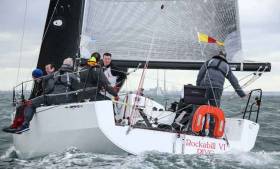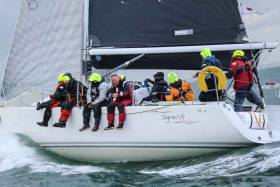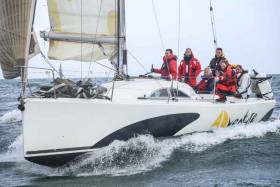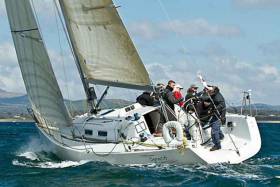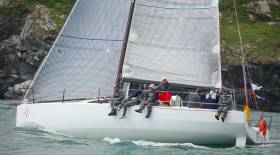Displaying items by tag: ISORA
ISORA Fleet Heads For Arklow (Race Tracker Here!)
A fleet of 28 ISORA yachts is heading south from Dublin Bay to Arklow this morning at 8am, a 48–mile coastal race that is expected to finish later this afternoon.
The great turnout is a boost for offshore sailors who already saw a turnout of 36 for the Holyhead to Dun Laoghaire Race a fortnight ago. Read W M Nixon's race preview in his Saturday blog here.
Arklow Sailing Club is preparing to welcome the fleet for the first time in many years.
The course choice for the fourth race in the Avery Crest ISORA 2017 series is as follows: Start off Dun Laoghaire - Muglins Island (S) - South Arklow (S) - N52 40.200' W5 58.892' and Finish off Arklow.
 Very light winds and an adverse tide meant this morning's exit from Dublin Bay took over an hour. With 32 miles still to sail to Arklow, British J109 Wakey Wakey (above with pink spinnaker) leads the 21–boat fleet on IRC while Stephen Tudor’s sistership Sgrech (blue spinnaker) is fifth. See current positions via tracker below Photo: Afloat.ie
Very light winds and an adverse tide meant this morning's exit from Dublin Bay took over an hour. With 32 miles still to sail to Arklow, British J109 Wakey Wakey (above with pink spinnaker) leads the 21–boat fleet on IRC while Stephen Tudor’s sistership Sgrech (blue spinnaker) is fifth. See current positions via tracker below Photo: Afloat.ie
The finish off Arklow could yet prove decisive becuase competitors are required to navigate to finish on a transit between Gypsum Chimney (On Land) at co-ordinates N 52 47.767' W 6 08.600' to the ASC Gypsum Mark (200 Lit Red Drum, 1 meter high) at co-ordinates N 52-47.764’ W 6-8.270’ and crossing in the direction from the previous mark.
The latest instructions to skipper stresses that the finish line is, as described above, between the co-ordinates, and NOT at the mark. The coordinate should be used as a waypoint gate in the navigation. This is to facilitate the YB trackers that track the fleet during the race.
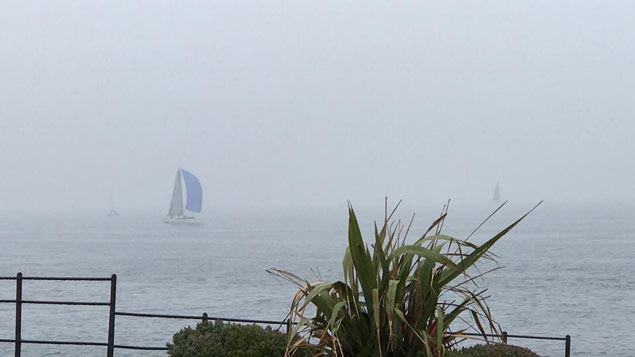 Spinnakers filling as the ISORA fleet pass Greystones Harbour in the rain. Photo: Aaron O'Gorman/Facebook
Spinnakers filling as the ISORA fleet pass Greystones Harbour in the rain. Photo: Aaron O'Gorman/Facebook
Track the fleet on the race tracker below:
Despite some interruptions from either too much or too little wind, the regular club sailing programme for 2017 is now fully under way, and this weekend is additionally so well filled with major regional and national events that you could be forgiven for thinking it’s high summer already. W M Nixon tries to make sense of it all.
How on earth is anyone expected to fully understand, let alone explain, a global activity which today sees the extraordinary 1,500 boat Festival of Sail in the Morbihan in France putting in its final races and fleet manoeuvres, before everyone joins in the end-of-show Parade of Sail tomorrow?
Yet at the same time, across the Atlantic in Bermuda, the first moves in the 35th edition of the America’s Cup, arguably the world’s oldest international sporting contest as it goes back to 1851, are getting under way, involving sailing machines for which the word “boat” seems somewhat inappropriate.
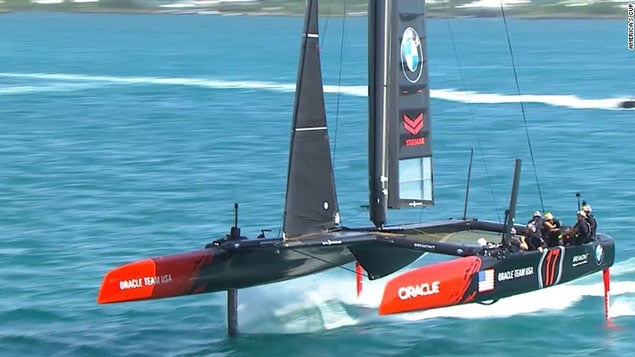 It’s difficult to think of them as anything other than “sailing machines,” but America’s Cup rules reckon they are boats
It’s difficult to think of them as anything other than “sailing machines,” but America’s Cup rules reckon they are boats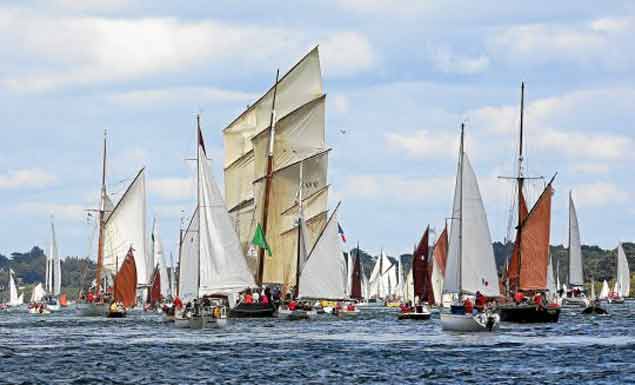 Some of the huge fleet at the current Morbihan festival. In their midst is the bisquine-rigged La Cancalaise from Cancale. In the days of piracy, smuggling and privateering in the English Channel, it was reckoned that any vessel setting this demanding high-performance rig was up to no good, and therefore a legitimate target for government ships
Some of the huge fleet at the current Morbihan festival. In their midst is the bisquine-rigged La Cancalaise from Cancale. In the days of piracy, smuggling and privateering in the English Channel, it was reckoned that any vessel setting this demanding high-performance rig was up to no good, and therefore a legitimate target for government ships
Then too, the world sailing community is still digesting the revelation that future generations of boats in the Volvo World Race, which now rivals the America’s Cup for international attention, will be in effect IMOCA 60s with mega-foils.
And in addition to that, at each in-harbour stopover, the world-girdling Volvo Ocean Race crews will be expected to do a series of races in smaller but very potent multi-hulls which will thrill spectators with their closeness to the watching crowds and to each other, with hair’s breadth misses – and ideally the occasional not-too-serious shunt - a central part of the action.
All these major international events then have to be fitted around the reality that, like it or not, sailing is one of those minority sports that need the Olympics more than the Olympics need sailing. In other words, we have to keep the decks clear of other major international fixtures to give total attention when the next sailing Olympiad at Tokyo comes along in 2020.
For those who would snort in derision at such a suggestion, do tell us what you were doing (if you can remember) while the rest of Ireland held its breath and watched as Annalise Murphy was sailing towards her Silver Medal on August 16th 2016?
Nevertheless, having taken all that into account, the reality is that the top end of sailing is reaching ever-higher peaks of performance in everything, and inevitably using boats and equipment of unimaginable expense. So except for the Morbihan event - whose ethos is found in going the other way, with total democratic involvement for everyone - how on earth can ordinary sailors relate to what the participants in the America’s Cup and the Volvo World Race are experiencing?
Let’s be honest. We can only do so - if at all - with some mighty leaps of the imagination. The result is that many of us are going back to the knitting. We’re going back to trusted events, and staying with sailing boats which may not be in the first flush of youth, but at least they mean something to us.
We know that with them, we can find racing which bears some relation to everyday life rather than the other-world dreamscape which is the America’s Cup or the Volvo World Race.
Over the next two weekends in Ireland, this racing of familiar boats will move up a couple of gears, as this weekend is the Bank Holiday in the North, and in a week’s time the extra day off is in the Republic. So keen sailors who see their programme on an all-Ireland basis somehow manage to convince themselves that we have two all-island Bank Holidays on the trot.
 Galway hookers gather at the Claddagh, while above them is the Galway City Museum, currently staging a Marine Science Exhibition.
Galway hookers gather at the Claddagh, while above them is the Galway City Museum, currently staging a Marine Science Exhibition.
Thus the ongoing Claddagh Festival with all varieties of Galway Hookers on show in the City of the Tribes is also managing to welcome Viking longships which have been brought overland from their home port of Ardglass in County Down. And at least the northerners have the proper claim that, for them, Monday is a free day to get their boats home again.
That equally applies to northern visitors to the Woodenboat Festival in Baltimore, which got going last night and should have good weather from midday onwards today, and through tomorrow’s colourful programme. Nevertheless for those with a day job to think about, the long haul home on Sunday night can become very long indeed.
 Baltimore in West Cork - the perfect location for a friendly Woodenboat Festival
Baltimore in West Cork - the perfect location for a friendly Woodenboat Festival
 It’s not quite racing, but when a Galway hooker (left) finds competition at Baltimore Woodenboat Festival with a traditional West Cork boat, there’s certainly an added edge to the sailing. Photo Sheena Jolley
It’s not quite racing, but when a Galway hooker (left) finds competition at Baltimore Woodenboat Festival with a traditional West Cork boat, there’s certainly an added edge to the sailing. Photo Sheena Jolley
Both these events are traditional annual festivals in which racing plays only a small – if any – part. But even in competitive sailing, all the signs are that people are returning to beef up the numbers and competition in events which served them well in the past, yet had slipped in the popularity ratings owing to a change in behavioural patterns (the modern family is an extremely demanding taskmaster), and the ill-effects of the economic recession.
Everyone has been heartened by the new strength of the Irish Sea Offshore Racing Association (to which we’ll return in a minute), but today the top of the agenda is the Scottish Series, getting up to speed at the lovely little port of Tarbert on Loch Fyne. Of course, numbers are nothing like the eventually unmanageable crowd of boats which became a feature of this series about twenty years ago. But nevertheless there’s a tidy fleet at Tarbert, and a strong Irish contingent are in with more than shout of bringing home the big prize.
 Packing them in – the Scottish Series fleet in Tarbert
Packing them in – the Scottish Series fleet in Tarbert
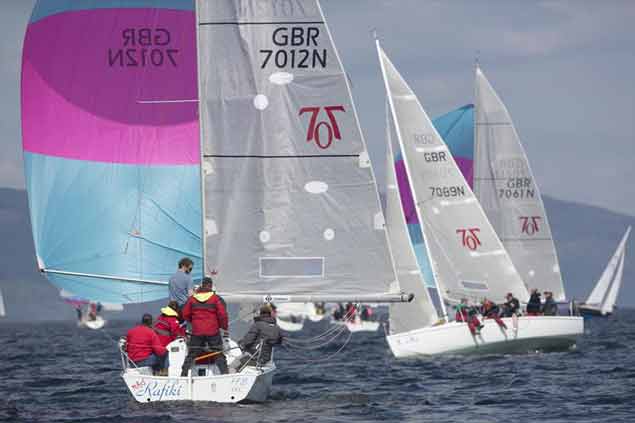 The Hunter 707 fleet provided some of the best racing at last year’s Scottish Series
The Hunter 707 fleet provided some of the best racing at last year’s Scottish Series
 Dara O’Malley (second left) and his winning crew on Seaword, which made him Afloat.ie “Sailor of the Month” for May 2016. Photo: Marc Turner
Dara O’Malley (second left) and his winning crew on Seaword, which made him Afloat.ie “Sailor of the Month” for May 2016. Photo: Marc Turner
Last year it was one of the diaspora, Dara O’Malley originally from Westport but now sailing on the Firth of Forth with his Hunter 707 Seaword, who was tops. While he may be Scottish-based, he was home among us in January to receive his Afloat.ie “Sailor of the Month” Award for May 2016 at the National Sailing Awards in the RDS.
He is defending this weekend, and another former overall winner is the irrepressible Rob McConnell from Dunmore East. With an almost entirely Waterford Harbour SC crew, Rob’s A35 Fool’s Gold is reportedly in particular good trim this year, so definitely a boat to watch.
Other strong performers from Ireland over in Tarbert include the Kelly family from Rush with their J/109 Storm, and that highly individualistic helmsman renowned for pulling rabbits out of the hat, Johnny Swan with his classic Half Tonner Harmony from Howth. Strangford Lough is sending the notably steady perfomer Jay Colville with his successful First 40 Forty Licks, while all the way from Cork Harbour is the First 36.7 Altair (K Dorgan & J Losty) of Cove Sailing Club, recalling the enthusiasm of a high order which used to be a feature of the O’Leary family’s years with the Corby 36 Antix from Crosshaven, an overall winner in Scotland on more than one occasion.
 They might do it again......Rob McConnell (fourth left) and his mostly Dunmore East crew after winning the Scottish Series in 2015 on the Archambault 35 Fool’s Gold. Photo: Marc Turner
They might do it again......Rob McConnell (fourth left) and his mostly Dunmore East crew after winning the Scottish Series in 2015 on the Archambault 35 Fool’s Gold. Photo: Marc Turner
The continuing growth of the J/109s, which have needed ten years to become an overnight success in Ireland, is shown by the additional presence in Scotland of two of Storm’s sister-ships from home, Andrew Craig’s Chimaera and John & Brian Hall’s Something Else, while a smaller manifestation of the J Boat range’s ubiquitous nature is the participation of Stephen Quinn’s J/97 Lambay Rules from Howth.
It’s an interesting crew setup, as Lambay Rules’ core team, including Stephen Quinn himself, have been seen racing in the elegance of Stephen O’Flaherty’s Spirit 54 Soufriere, whose claims to fame include a role in a James Bond movie. Despite the obvious differences between the two boats, the key personnel – including Stephen O’Flaherty – moved aboard the little Lambay Rules for last year’s Volvo Round Ireland Race, and despite being one of the smallest boats in the fleet (in fact, I think she was the smallest), at several stages they were leading their class, but not alas at the finish.
Their determined involvement in Scotland says much for their continuing zest in the game, but meanwhile back home the presence of so many significant boats over in Scotland has done little to diminish numbers for this morning’s ISORA Race from Dun Laoghaire to Arklow, which will see 28 starters.
PHOTO HERE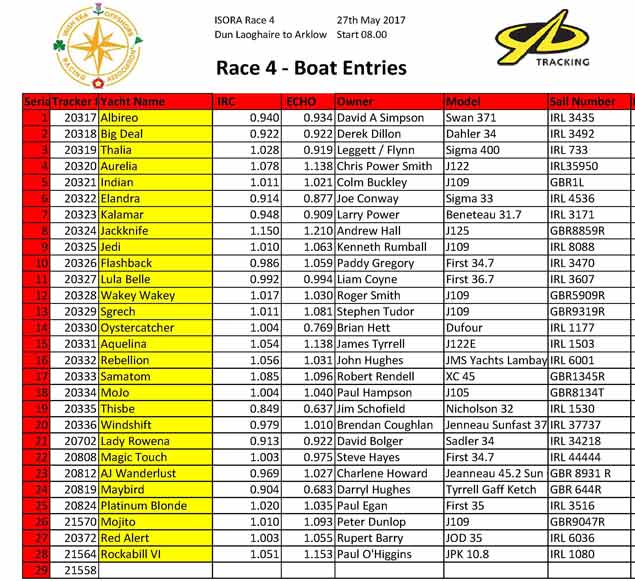 The lineup for today’s ISORA-Dun Laoghaire Race
The lineup for today’s ISORA-Dun Laoghaire Race
Very senior ISORA contenders have a feeling that they must have raced to Arklow before, but maybe they’re confusing it with ISORA races which took in the Arklow Lightvessel as a mark of the course, and it’s undoubtedly a very long time since a lightship was on the Arklow Bank.
Certainly ISORA Chairman Peter Ryan says that this is the first time an ISORA Race has finished in Arklow, where the local sailing club has been expanding in a healthy style, while on the bigger canvas, the Tyrrell family with their succession of ever-larger and successful craft in the J Boat range – all called Aquelina – has done much to have Arklow SC punching way above its weight on the national offshore racing scene.
The Tyrrells were too far ahead of the curve when they got their first Aquelina, a J/109, shortly after the new marque was introduced. Their hopes of getting a semi-One-Design J/109 class going didn’t take off. But today, racing their current J/122E Aquelina back to their home port, they’ll ruefully observe that there are at least five J/109s racing with them, a goodly number when we remember that three of the Dublin class are in Scotland, and several others are staying in Dun Laoghaire to do today’s Dublin Bay SC race.
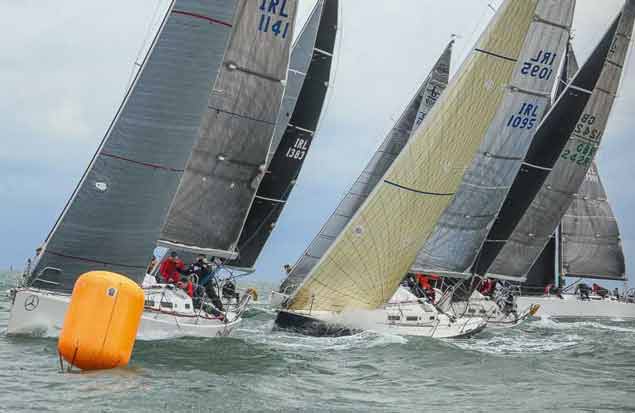 It has taken them ten years to become an overnight success, but the J/109s are now a very significant presence in Dublin Bay. Photo: Afloat.ie
It has taken them ten years to become an overnight success, but the J/109s are now a very significant presence in Dublin Bay. Photo: Afloat.ie
However, one of the latest J/09s to join the Greater Dublin class is Indian, owned by Colm Buckley and Simon Knowles of Howth. They won the two-handed class in the 2015 Dun Laoghaire to Dingle race in the smaller Elan Blue Eyes, but this race to Arklow is their first serious offshore challenge in the J/109. It will be a proper test, as the J/109 contingent includes Peter Dunlop’s Mojito and Stephen Tudor’s Sgrech, both from Pwllheli and respectively first and second of the J/109s in the Holyhead to Dun Laoghaire race a fortnight ago.
But the boat for everyone to beat is Paul O’Higgins’ JPK 10.80 Rockabill VI, whose remarkable all-round ability was demonstrated with the overall win in the increasingly breezy Holyhead-Dun Laoghaire Race of May 13th. These JPK 10.80s are superb performers across a wide range of conditions, and the simple fact of knowing they have such a good boat under them is an added encouragement for Paul O’Higgins and his crew of all the talents.
The highly technical approach of racing a boat like Rockabill VI is a whole world away from the intimate world of wooden boat adherents getting together in Baltimore, or the historical, cultural and music-laden gathering of the traditional craft and their visiting Vikings in Galway. But that’s the way it is in the very wide world of boats and sailing. In the end, we’re all members of the same exceptionally diverse sailing community.
 The boat to beat – Paul O’Higgins JPK 10.80 Rockabill VI is a superb all-rounder
The boat to beat – Paul O’Higgins JPK 10.80 Rockabill VI is a superb all-rounder
Once the ISORA fleet completes its fourth race to Arklow on Saturday, organisers have cooked up a novel and unique race five in the Averycrest sponsored series. Originally, it had been intended that ISORA would join with Howth Yacht Club in the Lambay Race but when the date of that race was brought forward it clashed with the ISORA race to finish in Dublin Port as part of the Dublin Port Riverfest. The solution was 'simple', according to ISORA's Peter Ryan, so they combined the two races into one event and will have two finishes!
There will be a special 'ISORA Class' in the HYC Lambay Race. Boats can enter both the ISORA Class of the Lambay Race and the ISORA Day Race. The start of both races will be provided by Howth YC and the course around Lambay will set by HYC.
The ISORA Class fleet will then proceed to the Lambay race finish off Howth where finish times will be recorded and prizes awarded. However, what is unique about this race is that the ISORA fleet will treat the finish line as a mark on the course and continue on the race toward the 'second finish' in Dublin Port.
The courses for both parts of this unique race will be circulated on the Thursday before the race.
This unique race will test the ability of the racing rules and the use of the YB trackers, but that is the challenge!
The interest and resulting entry for the Volvo Dun Laoghaire to Dingle D2D Race has exceeded all our expectations, writes race organiser Adam Winkelmann.
We now have 39 confirmed entries and expect to have close to 45 boats on the start line on Wednesday June 14th. Janet Grosvenor from RORC will be here to observe the start on June 14th and race management procedures with a view to our ambition to be a RORC endorsed race in 2019. I think with these numbers we are on a good path to that. There is no doubt that the resurgence in ISORA has been a significant factor in the growth and composition of the racing class. By adding RORC in the future we can expect other boats to enter to qualify their crew for the Fastnet Race later in the same year.
We have had a very positive reaction from sailors to our revised schedule of a Wednesday evening start and a Prizegiving Party in Benners Hotel in Dingle on Saturday June 17th. We have included a time limit of 18.00hrs on Saturday in the Sailing Instructions to ensure that we can proceed with prizes later that evening. This facilitates the sailors crew planning for a return to Sovereigns Cup or to work on Monday! We will be giving each boat a crate of Crean’s Beer on arrival in Dingle. Many boats have also booked accommodation with our long term partner the Dingle Skelligs Hotel and no doubt much of the post race analysis will take place in the bar there.
We are looking forward greatly to the start from the National Yacht Club in Dun Laoghaire on June 14th at 19.00hrs (starting area in Scotsmans Bay) and encourage as many as want to come out either on the pier or in boats to wave the fleet off on its journey. Yellow Brick tracking of the race will be available so families and supporters can follow the race from start to finish. If the crews bring the trackers to the pub with them as happened last time you will even be able to locate them there!
UPDATE: Comment From Sgrech skipper Stephen Tudor:
Sgrech is committed to the 'D2D' classic offshore race and will be on the starting line on June 14th.
The race provides offshore challenges at 270 miles but also some of the most spectacular scenery from the start in Dublin Bay, southwards down the banks along the east coast of Ireland, Tuskar Rock Light with her South Hen and Chickens. Along the south coast to Fastnet and onwards into the Atlantic.
The next corner the Bull, The Cow and The Calf - spectacular and it does look like a bull.
Next the Great Skellig - truly magnificent but watch out for the Washerwoman Rock - she is vicious!
Then north east to Dingle, the welcome from Fungie the resident dolphin.
Then there is Dingle - a fantastic destination and the high street pubs worth a visit before a party and a gentle cruise home! - Classic join us.
ISORA Chairman Peter Ryan adds: After the Round Ireland Race, it is one of the best offshore races in these waters. After the race, nothing matches the craic in Dingle.
Class divisions breakdown as follows:
11 Cruiser Class
3 Mini 650 Class
5 2 Handed Class
19 Racing Class
39 D2D entries to date are below:
|
ACT Two |
DuFour 425 |
IRL4250 |
Cruiser |
|
AJ Wanderlust |
Jeanneau 45.2 Sun Odyssey |
IOM 8931 R |
2-handed |
|
aquelina |
J-112E |
IRL 1507 |
Racing |
|
Aurelia |
J Boats |
IRL35950 |
Racing |
|
Birmayne |
Bruce Roberts |
IRL 756 |
Cruiser |
|
Cavatina |
Granada 38 |
IRL3861 |
Racing |
|
Elandra |
SIgma 33 |
IRL 4536 |
Racing |
|
EOS |
X 362 SPORT |
IRL 6695 |
Racing |
|
Fulmar Fever |
Westerly Fulmar |
FR 14 |
Cruiser |
|
Gemo |
Mini 650 Dingo 1 |
FR 699 |
2-handed |
|
Golden Fleece |
Sigma 41 |
IRL51215 |
Cruiser |
|
Harriet Marwood |
Farrow & Chambers, Collins 40 Tandem Keel |
GBR3556L |
Cruiser |
|
Indian |
J109 |
1543 |
2-handed |
|
IOS Desert Star |
Jeanneau |
irl 1397 |
Racing |
|
Jedi |
J109 |
IRL 8088 |
Racing |
|
Juggerknot |
J/109 |
IRL 3660 |
Racing |
|
Lady Rowena |
Sadler |
IRL34218 |
Cruiser |
|
Lively Lady |
Beneteau First 44.7 |
IRL1644 |
Racing |
|
LOBSTER |
Two Ton Dubois |
IRL 7077 |
2-handed |
|
Maybird |
Shepherd design built by Jack Terrell in 1937 |
GBR 644R |
Cruiser |
|
Mojito |
J/109 |
GBR0947R |
Racing |
|
Oystercatcher |
Dufour |
IRL 1177 |
Cruiser |
|
Pamela |
Discovery 55 |
IRL5503 |
Cruiser |
|
Pipedreamer VI |
Dufour 40 |
GBR 2271L |
Cruiser |
|
Platinum Blonde |
Beneteau 35 First |
IRL 3516 |
Racing |
|
Port of Galway Black |
Mini 6.50/ Proto |
303 |
2-handed |
|
Port of Galway Green |
Mini Transat 6.5 Proto |
IRL78 |
2-handed |
|
Prima Luce |
Beneteau First 35 |
IRL 3504 |
2-handed |
|
Rockabill VI |
JPK 10.80IRL |
IRL 10800 |
Racing |
|
Ruth |
J/109 |
IRL 1383 |
Racing |
|
Soufriere |
Spirit 54 |
IRL 1974 |
2-handed |
|
Spirit of Jacana |
J133 |
IRL1335 |
Racing |
|
Thalia |
Sigma 400 |
IRL733 |
Racing |
|
Thisbe |
Nicholson 32 |
IRL 1530 |
Cruiser |
|
Wakey Wakey |
J109 |
GBR5909R |
Racing |
|
White Tiger |
Beneteau First 44.7 |
IRL4470 |
Racing |
|
Windshift |
Sunfast 37 |
37737 |
Racing |
|
WOW |
Austral Yachts |
IRL4208 |
Racing |
Big ISORA Fleet Has 8am Start for First Race To Arklow
Saturday's fourth ISORA race of the season starts from Dun Laoghaire, County Dublin and finishes in Arklow, County Wicklow. The 60–mile race will be the first ISORA visit to Arklow for many years and Arklow Sailing Club, as previously reported by Afloat.ie, is preparing a warm welcome for the offshore fleet with over 32–boats expected for the 8am start off Dun Laoghaire Harbour.
The 'Sailing Instructions and Supplementary Information for Race 4' are attached below.
The ISORA fleet has grown to 50 boats for the 2017 season with fixtures on both sides of the Irish Sea.
Rockabill VI Tops In ISORA Dash To Dun Laoghaire
Paul O’Higgins JPK 10.80 Rockabill VI has won overall in a fast ISORA Holyhead-Dun Laoghaire Race today writes W M Nixon. After the 0800hr start, a blistering pace was set in a rising southwest to south wind which obligingly backed when the fleet were making their way from the M2 buoy at mid-Channel to leave the South Burford Buoy to starboard before streaking in to Dublin Bay to finish around 1600hrs, a good hour ahead of the most optimistic predictions.
Corrected times at the finish were very close, and a superb performance was put in by the two-handed crew of the Sunfast 3600 Bam!. Owner Conor Fogerty sailed with Robert Slator and such determination that Rockabill was only 2 minutes and 24 seconds ahead. Four minutes later on CT came the J/109 Mojito (Peter Dunlop), and seven minutes after that came sister-ship Sgrech (Stephen Tudor).
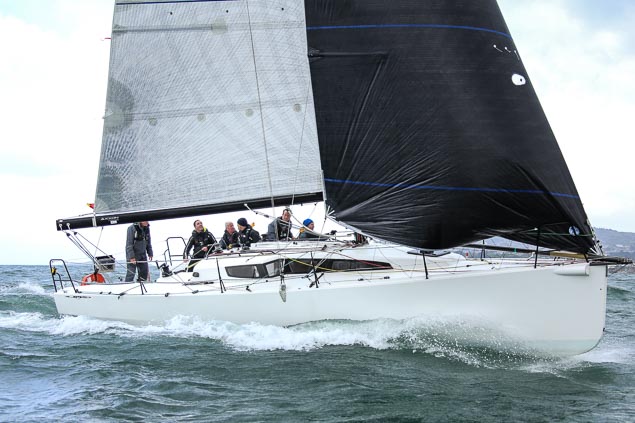 Paul O’Higgins JPK 10.80 Rockabill VI has won overall in a fast ISORA Holyhead-Dun Laoghaire Race. Photo: Afloat.ie
Paul O’Higgins JPK 10.80 Rockabill VI has won overall in a fast ISORA Holyhead-Dun Laoghaire Race. Photo: Afloat.ie
A remarkable performance was put in by the big new Hanse 445 Pleione of Dee (Derek Matthews), which brings luxurious cruising style to Irish Sea offshore racing. She came across the Channel like a rocket, and placed 5th overall on IRC and first overall on ECHO, beating Brendan Couglan’s second-placed Jeanneau Sunfast 337 Windshift by three minutes.
Peter Ryan, ISORA Chairman adds:
The first offshore race of the ISORA Avery Crest Offshore Championship 2017 took place on the 13th May. 32 boats from the entry list of 36 came to the start line in Holyhead.
The weather forecast was predicting southerly winds increasing fresh to strong later in the day. For the first offshore of the season, and to minimise the exposure of the fleet to the later conditions, the course was chosen to be from the start at Holyhead, taking the M2 weather buoy to port, South Burford to starboard and then to the finish. A distance of 59 miles.
The start at 08.00 was provided by Dawn Russell of Holyhead Sailing Club using the Pier lighthouse and the Clipperra buoy. Despite a huge natural bias on the line for the lighthouse end, boats appeared to be happy spread along the start line in the gusting winds.
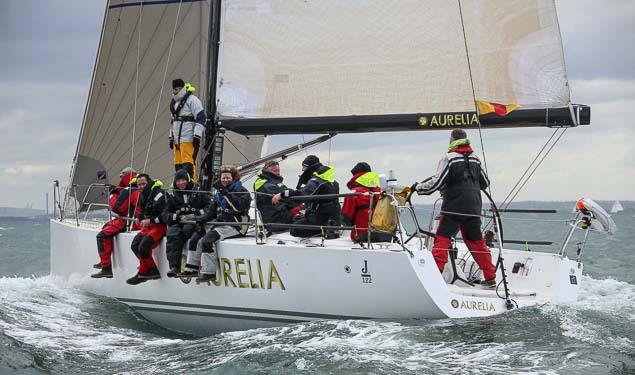 Chris Power Smith' Aurelia J122 was seventh on IRC Photo: Afloat.ie
Chris Power Smith' Aurelia J122 was seventh on IRC Photo: Afloat.ie
Not only was wind going to be the issue for the fleet but a very strong north going tide at the start would push the fleet northwards, turning what should have been a tight spinnaker leg to M2 into a loose fetch. The fleet headed towards M2, some allowing the tide to push them north while others sailed tighter and remained on the rhumb line. Conditions for the first leg were averaging 20knots SSW.
Andrew Hall’s “Jackknife” lead the fleet to the M2, located half way across the Irish Sea. At rounding the mark, the fleet was well bunched, encouraging crews to maintain speed in the blustery conditions.
The leg to South Burford was a tight fetch. It was hoped that the turning tide would push the fleet southwards allowing boats to free up in the increasing winds and sea state. This did not happen until much later in the race – a favourable tide turns quickly, the unfavourable tide never appears to turn?
Conditions as the fleet approached South Burford had deteriorated. The winds had increased to 27 knots southerly will greater gusts. The sea state were particularly bad close to the Burford Bank with winds against tide. Once in Dublin Bay, calm was restored and the final 4 mile reach to the finish was a relief. Despite the wind backing to SE close to the finish, none of the battered crews attempted to launch spinnakers.
The finish line was between the pier heads in Dun Laoghaire and the constant procession of boats kept the Finishers, Grainne Ryan, Kathryn Meghen and Anita Begley busy. The trackers were also used to provide finish time and these worked well, providing instant provisional results on the YB Tracking app and ISORA website.
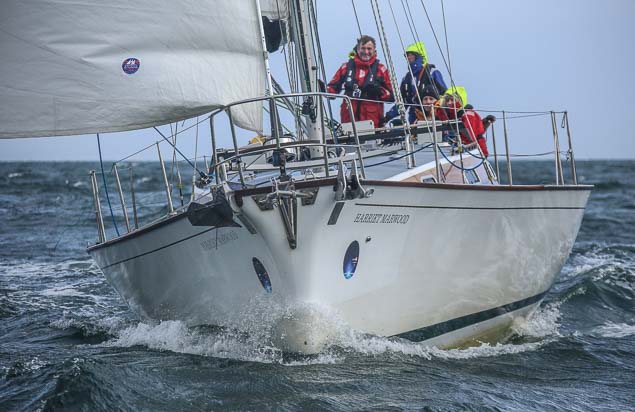 The flared bow of Bryan Mullarkey's Collins TC, Harriet Marwood, is clear from this head–on photograph. The British entry was tenth on IRC Photo: Afloat.ie
The flared bow of Bryan Mullarkey's Collins TC, Harriet Marwood, is clear from this head–on photograph. The British entry was tenth on IRC Photo: Afloat.ie
“Jackknife” maintained the lead and took line honours after 7 hours and 34 minutes racing, just over one minute ahead of Neil Eatough’s “Forthy Shades”. Paul O’Higgins “Rockabill VI” took IRC Overall and Class 0, breaking the “J Boats monopoly” of the recent results. IRC Class 1 was won by Peter Dunlop’s “Mojito” pursued relentlessly through the race by Stephen Tudor’s “Sgrech” who took 2nd place IRC Class 1. IRC Class 2 and Silver Class was won by Charlene Howard’s “AJ Wanderlust”. The newly adopted “ISORA Progressive ECHO” worked fantastically well giving Derek Matthews “Pleione of Dee” ECHO Overall and Class 0. Of the 32 starters, 31 boats finished with Brian Hett’s “Oystercatcher” retiring soon after the start with gear trouble.
After the exhausting race many of the visiting boats tied up at the National Yacht Club and the usual “apres sail” commenced.
Despite not ideal conditions, the general opinion of the race was “tough but rewarding”.
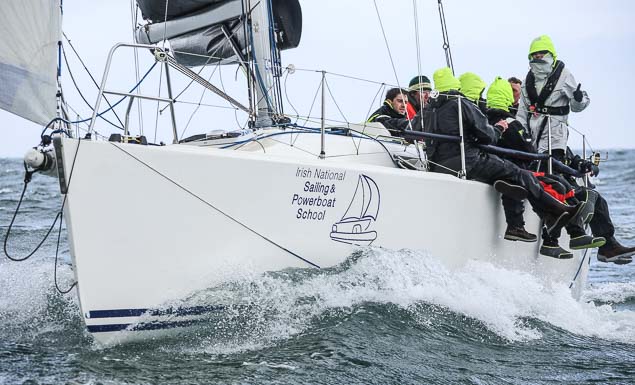 JEDI, the INSS J109 finished eighth under skipper Kenny Rumball. Photo: Afloat.ie
JEDI, the INSS J109 finished eighth under skipper Kenny Rumball. Photo: Afloat.ie
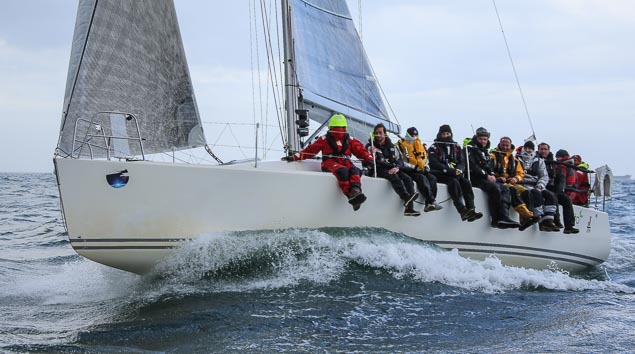 J/109 Mojito (Peter Dunlop) above was seven minutes ahead of sister-ship Sgrech (Stephen Tudor) (below) on corrected time. Photos: Afloat.ie
J/109 Mojito (Peter Dunlop) above was seven minutes ahead of sister-ship Sgrech (Stephen Tudor) (below) on corrected time. Photos: Afloat.ie
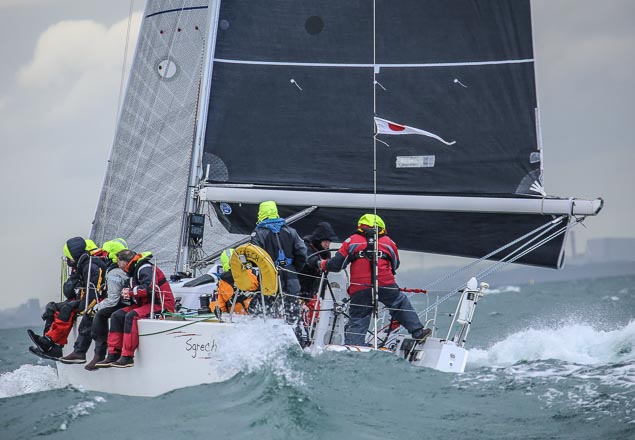
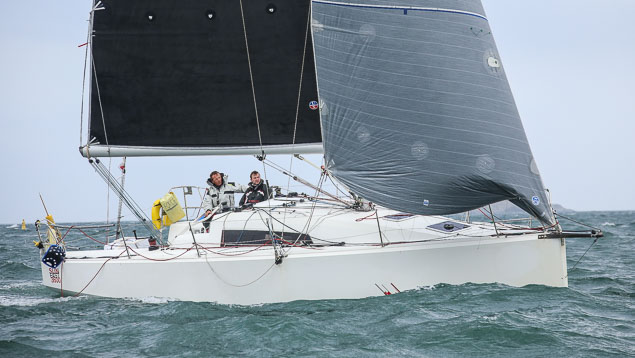 Bam skipper Conor Fogerty sailed double-handed with Robert Slator and such determination that Rockabill was only 2 minutes and 24 seconds ahead Photo: Afloat.ie
Bam skipper Conor Fogerty sailed double-handed with Robert Slator and such determination that Rockabill was only 2 minutes and 24 seconds ahead Photo: Afloat.ie
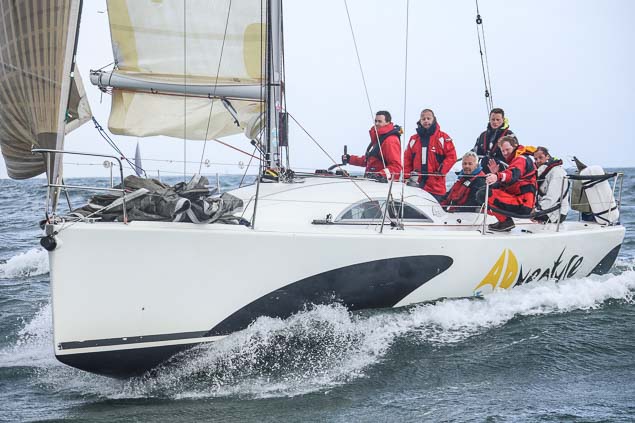 Daragh Cafferkey's Greystones Sailing Club entry Another Adventure finished 16th on IRC
Daragh Cafferkey's Greystones Sailing Club entry Another Adventure finished 16th on IRC
 Paul Egan's Platinum Blonde, a First 35, finished 17th on IRC
Paul Egan's Platinum Blonde, a First 35, finished 17th on IRC
Results are here
Two-Hander 'Bam' From Howth Yacht Club Takes Early Lead in ISORA Holyhead–Dun Laoghaire Race (Tracker HERE!)
Howth Yacht Club's Conor Fogerty is the early IRC leader in this morning's ISORA race from Holyhead to Dun Laoghaire. Fogerty's two–handed Jeanneau Sun Fast leads from Welsh yacht Jackknife with Royal Irish Yacht Rockabill VI (Paul O'Higgins) third and 47nm still to race.
The 32–boat fleet for the Avery Crest sponsored race is as follows: M2 Weather Buoy (P), the South Burford (S) and a finish off Dun Laoghaire.
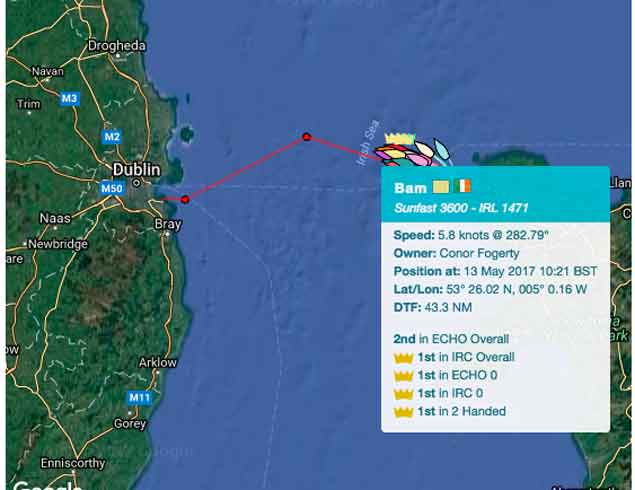 BAM leads across the Irish Sea in today's ISORA race
BAM leads across the Irish Sea in today's ISORA race
Leaders are currently expected into Dublin Bay around 5pm this evening.
Read also WMN Nixon's race preview here
An Alternative Pace For Irish Sailing In 2017?
After the accelerating build-up to Olympic Medal success throughout the summer of 2016, there was hope in some sections of the Irish sailing community that the mood of 2017 might be different in pace. Tokyo 2020 still seemed very far away to everyone except the most dedicated Olympians. There appeared to be a feeling that 2017 should be the year for everyone else, and particularly for those who yearned for a less competitive enjoyment of boats and sailing. W M Nixon takes stock.
Once upon a time, we had seasons. Sailing wasn’t 12 months of the year, let alone 24/7. On the contrary, there were the rare old times of Opening Days and Closing Days (we’re talking annual sailing programmes here, not pubs), and Launching Suppers and Hauling Up Suppers and whatever, and not a sail to be seen at Christmas except for the rare oddball whose very rarity underlined the unusual nature of such a sight in the dead of winter.
But now we have wetsuits, and the effectively year-round programme at many sailing centres – in my own club at Howth, for instance, it has been continuous since April 1974 thanks to that Autumn’s introduction of the Frostbite series for the then new-fangled Lasers. And if you’re not actually out sailing yourself, there’s the means of keeping up with those who are, a classic case being the following of the tracker for this past week’s 500-mile Mini-en-Mai race by Tom Dolan, which had certain goggle-eyed adherents clicking-in at ungodly hours of the night to see how our man was doing.
It was a race being sailed at a flat-out pace and a level of concentration - despite a sleep-deprived physical and mental state – beyond the comprehension of most of the rest of us. Good luck to those who feel drawn to it personally, and can do it. But today, there’s an ISORA race from Holyhead to Dun Laoghaire under way that is catering for all levels of involvement and commitment, and it has attracted a worthwhile starting line-up of 31 boats, encouraged by the welcoming efforts of ISORA Commodore Peter Ryan and his team.
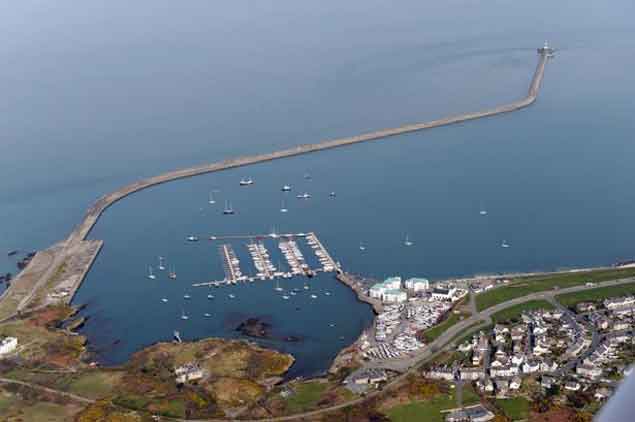 Holyhead Harbour as sailing people know it – not as a utilitarian ferry port, but as a pleasant corner called Porth-y-Fellyn where there’s a sailing club, marina and boatyard
Holyhead Harbour as sailing people know it – not as a utilitarian ferry port, but as a pleasant corner called Porth-y-Fellyn where there’s a sailing club, marina and boatyard
The word on the waterfront is that hyper-racers – people who expect three or four windward/leeward races per day at an intensely-run regatta – tend to dismiss this growing contemporary trend back towards classic Irish Sea Offshore Racing Association courses as sailing for people who can’t hack it in the frequent cut-and-thrust of artificial courses. But that’s to take a “one size fits all” attitude to sailing. If there’s one indisputable feature about our sometimes very odd sport, it’s the variety of the people involved in it – and that’s before you even consider the different type of boats.
On top of that, not only are there people who can get all their sailing enjoyment without needing to race at all, but there are grades of dedication in competition in sailing. This was particularly apparent a couple of years ago down at Dromineer on Lough Derg, when classes of Dragons, Flying Fifteens and Squibs descended on the place for the annual end-of-season Freshwater Challenge in October.
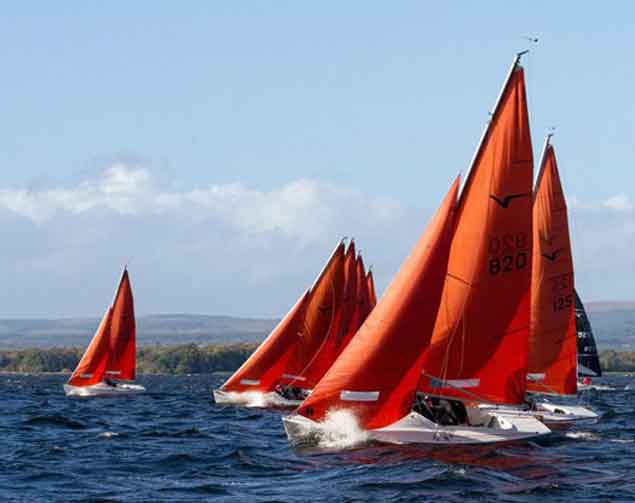
Top Squibs from all over Ireland gearing themselves up for two days of intensive racing at Dromineer. But it emerged that for many of the local fleet, they weren’t into this sort of thing at all. Photo: Gareth Craig
There was an impressive fleet of top Squibs from all over Ireland out racing like fury on the lake. But there was also a substantial number of local Squibs that stayed in their berths. And it emerged that they hadn’t even entered the event in the first place. It seems that the Dromineer Squibs had been bought by people who saw them as handy and surprisingly comfortable little boats in which you could take the children, or more likely the grandchildren, out for a fun sail. And maybe you and a friend could do the occasional gentle summer’s evening club race for a bit of sociability. But the idea of committing to a frantic weekend of top competition was anathema.
Now while we’re not suggesting that the 31 boats which will be starting this morning in the ISORA Holyhead to Howth Race include a significant sector which are anti-competition, nevertheless there’s a distinctly relaxed atmosphere in some of the fleet in the knowledge that their abilities will be recognized by the use of Progressive ECHO handicap in tandem with the ruthless calculations of IRC.
The Number-Cruncher-in-Chief, Denis Kiely of the Irish Cruiser Racing Association, set to during the winter in his lair in Kinsale and ran the figures from all last year’s ISORA racing through his mincer to come up with an ECHO handicap (which is performance based) for boats of all kinds, and these figures were available to get things going this year.
 The Irish National Sailing School’s keelboat fleet includes (left to right) the Reflex 38 Lynx, the Elan Beaufort, and the J/109 Jedi which is doing today’s cross-channel race.
The Irish National Sailing School’s keelboat fleet includes (left to right) the Reflex 38 Lynx, the Elan Beaufort, and the J/109 Jedi which is doing today’s cross-channel race.
Thus we find that a boat like the Kenneth Rumball-skippered J/109 Jedi from the Irish National Sailing School in Dun Laoghaire is racing today on an IRC of 1.010 while her ECHO is 1.075, but against that the majestic Nicholson 58 Rebellion (John Hughes) has an IRC of 1.056, but her ECHO is only 0.999.
With Progressive ECHO, it’s a flexible figure which encourages regular participation, for if you’ve had a bad day at the races, next time out you’ll find your Progressive ECHO has progressed even further southwards.
It all seems too gentle to be worth even thinking about by those whose every thought is competitive. But for those who enjoy settling down for a long haul at sea, with the opportunity to test boat and crew in the gentlest possible manner against other craft, it all has a certain appeal.
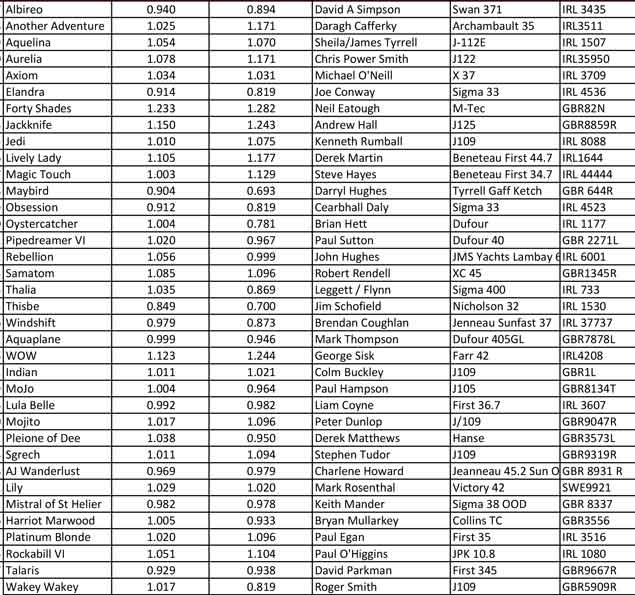 The fleet in today’s race shows interesting comparisons between IRC and Progressive ECHO handicaps. Some have not made the line, including the veteran ketch Maybird, but a late addition not listed is the Sunfast 3600 Bam (Conor Fogerty)
The fleet in today’s race shows interesting comparisons between IRC and Progressive ECHO handicaps. Some have not made the line, including the veteran ketch Maybird, but a late addition not listed is the Sunfast 3600 Bam (Conor Fogerty)
And it will be interesting on several levels, for not only have we boats of a definite cruiser-orientation whose crews are going along because ISORA has gone out of its way to offer the alternative of a developing handicap system which might reward their efforts, but up at the sharp end of the fleet there’ll be some very interesting performance comparisons to be made between hot boats as they race in what looks likely to be quite brisk conditions.
 Given a chance, she’ll fly – Neal Eatough’s Forty Shades is an M-Tec Open 40.
Given a chance, she’ll fly – Neal Eatough’s Forty Shades is an M-Tec Open 40.
The expectation is of a fresh to strong sou’westerly which mercifully will back during the day to free the fleet up to lay the course to Dublin Bay, in fact it might free them so much that one of the more interesting newcomers, Neal Eatough’s Open 40 M-Tec Forty Shades, could be across in half a day.
Another boat which will revel in a freeing breeze is Conor Fogerty’s Sunfast 3600 Bam – the Howth skipper is doing it two-handed with clubmate Robert Slator, and he sees the forecast weather pattern as providing them with a real chance.
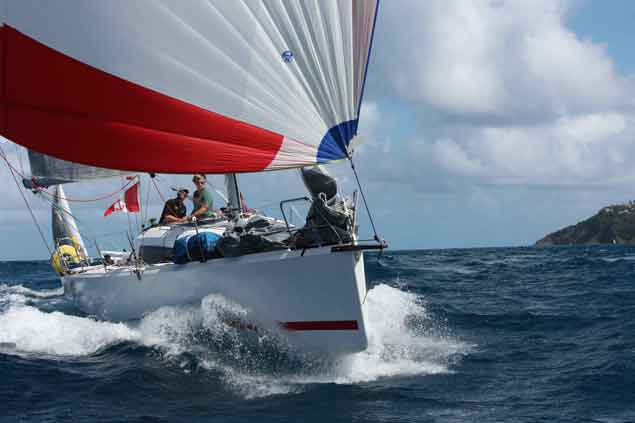 Conor Fogerty’s successful Sunfast 3600 Bam! – a class winner in the RORC Caribbean 600 2016 – is a late entry, and he’ll be doing the race two-handed with Robert Slator
Conor Fogerty’s successful Sunfast 3600 Bam! – a class winner in the RORC Caribbean 600 2016 – is a late entry, and he’ll be doing the race two-handed with Robert Slator
Inevitably the smart money will be on Paul O’Higgins’ JPK 10.80 Rockabill VI, but with no less than six J/109s in the mix, there’ll always be at least one potent representative of this hot class ready to pounce if there’s the slightest let-up in the pace on the JPK 10.80.
One of these J/109s is of course Stephen Tudor’s defending ISORA Overall Champion Sgrech from Pwllheli, a boat which is the very personification of ISORA’s cross-channel community, as her regular crew includes ISORA Commodore Peter Ryan, who is also a former Commodore of the National YC.
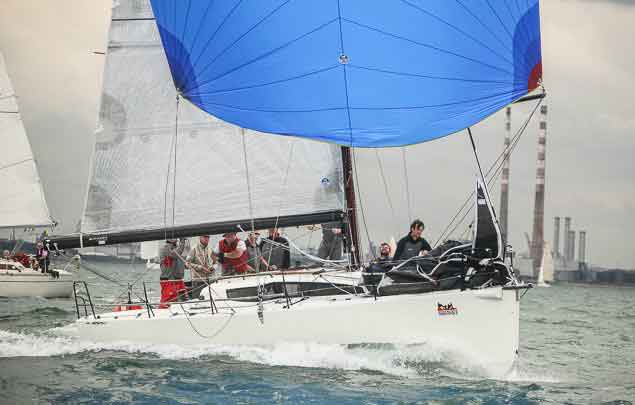 Paul O'Higgins JPK 10.80 Rockabill VI is one of the favourites for IRC success. Photo Afloat.ie
Paul O'Higgins JPK 10.80 Rockabill VI is one of the favourites for IRC success. Photo Afloat.ie
As anyone who has ever sailed on one of the Pwllheli boats will know, there’s always a smattering of Welsh spoken among the crew. Aboard Sgrech, says Peter, they speak little else except when they want to curse and swear, when they’ll tell you – with solemn faces – that there are no swear words in Welsh.
“Somehow we understand each other,” says Peter, “but Welsh is so different – not just from English, but from Irish too – that you could sail regularly with them for 45 years and still know very little of this strange tongue that they talk away in all the time”.
Perhaps it’s the underlying camaraderie of the sea which enables the communicational oddity which is Sgrech to be so effective, but then too, the shared enthusiasm of Stephen Tudor and Peter Ryan is infectious, and sometimes it spreads to the entire fleet.
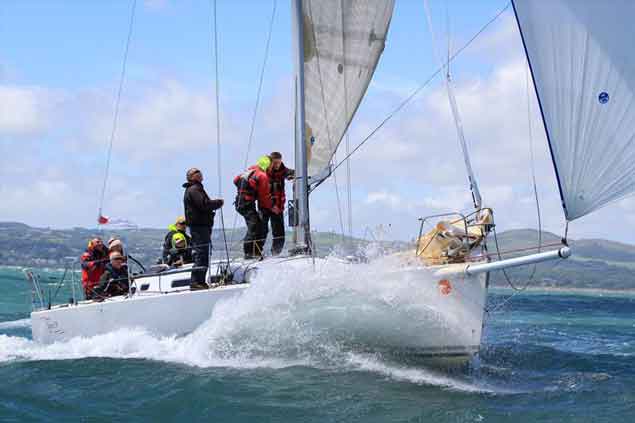 Sgrech at full chat. When you’re sailing like this and something goes wrong, then you really do know if there are no swear words in Welsh....
Sgrech at full chat. When you’re sailing like this and something goes wrong, then you really do know if there are no swear words in Welsh....
Thus the Commodore of ISORA expected a bit of a party in Holyhead Sailing Club last night notwithstanding the prospect of a windward slug first thing this morning (start was at 0800hrs today, there’s a tracker) and equally, with everyone energised by the day’s freeing wind (DV), he confidently anticipates an even more boisterous gathering in the National tonight.
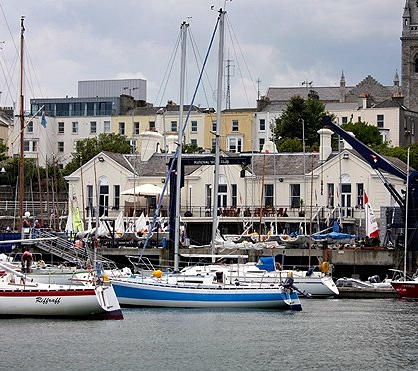 Welcome home. The National Yacht Club will be the venue for tonight’s post-race party.
Welcome home. The National Yacht Club will be the venue for tonight’s post-race party.
The ghost of the great John Illingworth, who did so much for the development of offshore racing in the 1940s, ’50s ’60s and ’70s, would approve, as he thought an offshore race without a good party beforehand and an even better one afterwards was not really a proper offshore race at all. That said, Illingworth’s most famous boat, Myth of Malham, was notorious for her paucity of cleats. When a newcomer to the crew demanded to know where he should cleat the headsails, an old hand told him they didn’t cleat the headsail sheets in the masthead cutter rig, as they trimmed the sails all the time....
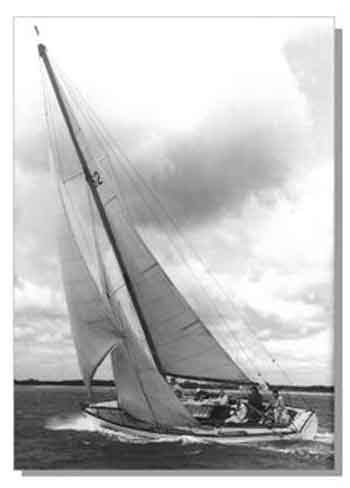 Myth of Malham. John Illingworth’s double Fastnet Race overall winner was renowned for her shortage of cleats.
Myth of Malham. John Illingworth’s double Fastnet Race overall winner was renowned for her shortage of cleats.
In today’s cross-channel dash, I’ve no doubt there’ll be many boats where sheets are cleated while crews settle down to enjoy the satisfaction of the boat trimmed reasonably well and making progress without the prospect of having to make a lot of irritating tacks before the finish. It’s different strokes for different folks.
Earlier this week I found myself studying a boat which is about as different from what your average ISORA racer expects in a boat as is humanly possible. This is Ian Lipinski’s 8.65 metres Griffon which took overall line honours in the 500-mile Mini-en-Mai at La Trinite at 0508hrs Irish time yesterday morning.
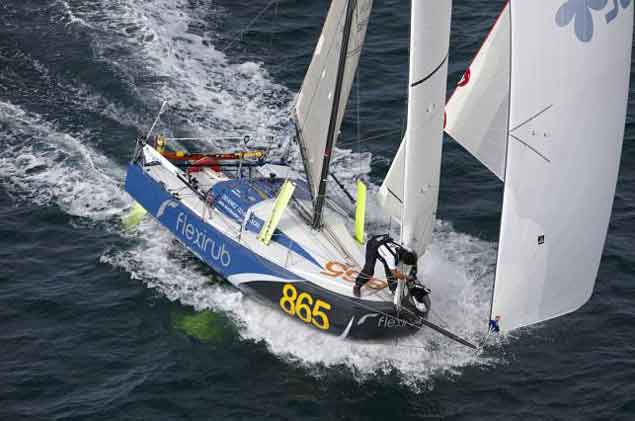 It would be a day’s work for a crew of five to race her- yet Ian Lipinski sails his odd-looking and demanding Proto, the 8.65 metres Griffon, single-handed and he wins too.
It would be a day’s work for a crew of five to race her- yet Ian Lipinski sails his odd-looking and demanding Proto, the 8.65 metres Griffon, single-handed and he wins too.
Griffon is the current pace-setter in the Proto section (prototypes in other words), and she’s a veritable floating laboratory for every development imaginable, including being at the forefront in the testing of foils. Obviously she’s also showing an aversion to that traditional notion of sweetly hollow waterlines forward, as exemplified by the schooner America. And if you dismiss her forward hull shape as being like a Dutch barge, next time you’re near an International Dragon, take a look at her forward waterlines – you might be surprised.
But the thing that really strikes me about Griffon is the number of tasks that the lone skipper has to perform all on his own to keep this machine at optimum performance. The sailplan alone is a 24/7 challenge, and rig optimization is part of it. Add in two daggerboards whose deployment offers multiple choices. Then you must never forget the ideal positioning of the canting keel in ever-changing circumstances. All that done, you still have to sail and navigate the boat. And if on top of all that you can find time to fire off visual and verbal communications with shore and sponsors, joy is unconfined....
Contrast that with the mood that might prevail aboard one of the heftier and more luxurious contenders in today’s Holyhead-Dun Laoghaire. The boat is nicely in trim, and it’s up to the helmsman to keep her there, and if it’s the autohelm as is now permitted, so be it. Alert as ever, the crew noticed a useful backing of the wind a while back, and sheets were adjusted accordingly and then cleated home. My word, but we’re racing keenly. And can that clock really be right? If so, it’s time for Nooners...
After next weekend's Holyhead– Dun Laoghaire Race, there is another buoyant turnout in prospect for ISORA (34 boats are already entered) for a new offshore race at the end of May. This particular offshore race on May 27th is unique as it will start and finish on the 'Irish side' – starting in Dun Laoghaire and finishing in a new port for ISORA, Arklow, in County Wicklow.
ISORA chief Peter Ryan says, 'We are looking forward to a great reception from Arklow Sailing Club'.
36 boats have entered the first ISORA offshore race to take place next Saturday. The offshore race will be approximately 60–miles, depending on the weather, starting in Holyhead and finishing in Dun Laoghaire. See attached ISORA entry list list below.
The fleet is a great cross section, from classic to high tech and from small to large, demonstrating the range of boats that are interested in racing offshore. The newly adopted “ISORA Progressive ECHO” will ensure a greater spread of prizes for the race with prizes for six classes and trophy for overall as well as the famous “Race Winners Jacket”, says ISORA's Peter Ryan.
The gathering of such a large numbers of boats and their crew in Holyhead on the Friday evening and again hopefully at the NYC on Saturday evening will generate a great social atmosphere, adds Ryan.
After Holyhead to Dun Laoghaire, the ISORA fleet gather again for a new offshore race to Arklow on May 27th. Read more on that new race here.




























